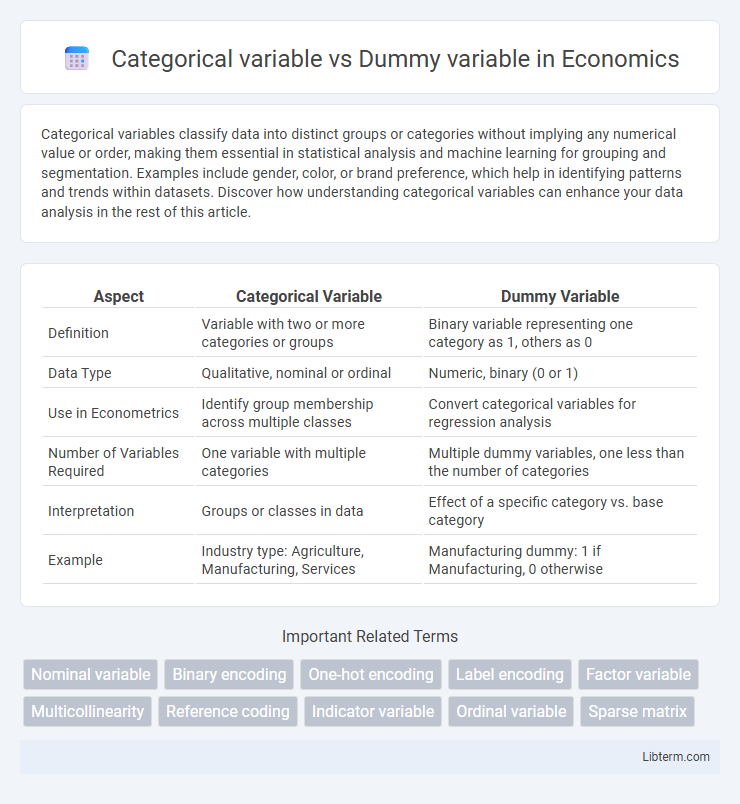Categorical variables classify data into distinct groups or categories without implying any numerical value or order, making them essential in statistical analysis and machine learning for grouping and segmentation. Examples include gender, color, or brand preference, which help in identifying patterns and trends within datasets. Discover how understanding categorical variables can enhance your data analysis in the rest of this article.
Table of Comparison
| Aspect | Categorical Variable | Dummy Variable |
|---|---|---|
| Definition | Variable with two or more categories or groups | Binary variable representing one category as 1, others as 0 |
| Data Type | Qualitative, nominal or ordinal | Numeric, binary (0 or 1) |
| Use in Econometrics | Identify group membership across multiple classes | Convert categorical variables for regression analysis |
| Number of Variables Required | One variable with multiple categories | Multiple dummy variables, one less than the number of categories |
| Interpretation | Groups or classes in data | Effect of a specific category vs. base category |
| Example | Industry type: Agriculture, Manufacturing, Services | Manufacturing dummy: 1 if Manufacturing, 0 otherwise |
Introduction to Categorical and Dummy Variables
Categorical variables represent data sorted into distinct groups or categories without intrinsic order, such as colors or brands. Dummy variables convert these categorical variables into binary numeric indicators (0 or 1) used in regression models to handle qualitative data effectively. This transformation enables statistical algorithms to process categorical information by encoding each category as a separate dummy variable.
Understanding Categorical Variables
Categorical variables represent data that can be divided into distinct groups or categories without intrinsic numerical order, such as colors or types of animals. These variables are essential in statistical analysis for organizing qualitative data and can be either nominal or ordinal. To incorporate categorical variables into regression models, they are often transformed into dummy variables, which are binary indicators representing each category.
Types of Categorical Variables
Nominal and ordinal are the two primary types of categorical variables where nominal variables represent categories without intrinsic order, such as gender or color, while ordinal variables indicate categories with a logical order, like customer satisfaction ratings. Dummy variables are binary indicator variables created from categorical variables to represent each category as 0 or 1, commonly used in regression models. These transformations enable machine learning algorithms to process categorical data effectively by converting qualitative information into a numerical format.
Definition of Dummy Variables
Dummy variables, also known as indicator variables, are numerical representations of categorical variables used in regression analysis to include qualitative data. Each dummy variable takes the value 0 or 1, indicating the absence or presence of a specific category within a categorical variable. This transformation allows statistical models to process categorical information effectively by converting categories into a binary format.
Purpose of Dummy Variables in Data Analysis
Dummy variables serve to transform categorical variables into a numeric format suitable for regression models and other statistical analyses by encoding categories as binary vectors. They facilitate the inclusion of qualitative data in predictive modeling, allowing algorithms to interpret categorical distinctions without assuming a natural order. This conversion enables precise estimation of category-specific effects on the dependent variable, enhancing model interpretability and prediction accuracy.
Comparing Categorical and Dummy Variables
Categorical variables represent groups or categories with multiple levels, such as "color" with values like red, blue, or green, while dummy variables convert each category into binary indicators, typically 0 or 1, for use in regression models. Unlike categorical variables that hold qualitative values, dummy variables enable machine learning algorithms to interpret categorical data by encoding them numerically. This transformation is essential for statistical modeling because many algorithms cannot process non-numeric inputs directly, requiring categorical data to be represented as dummy variables to capture group membership effectively.
Techniques for Converting Categorical to Dummy Variables
Converting categorical variables to dummy variables involves one-hot encoding, where each category is transformed into a binary column representing category presence. Label encoding assigns numeric values to categories but is less suitable for nominal data due to implied ordinality. Techniques such as pandas' get_dummies() function or sklearn's OneHotEncoder automate dummy variable creation, essential for machine learning models requiring numerical inputs.
Advantages of Using Dummy Variables
Dummy variables simplify the inclusion of categorical data in regression models by converting categories into binary indicators, allowing clear interpretation of coefficients. They enable flexible modeling of non-numeric data without imposing an ordinal relationship, preserving the categorical nature. This approach enhances model accuracy and facilitates hypothesis testing for individual category effects.
Common Pitfalls in Dummy Variable Creation
Common pitfalls in dummy variable creation include the omission of the reference category, leading to multicollinearity known as the dummy variable trap. Using too many dummy variables for categories with numerous levels can cause overfitting and reduce model interpretability. Incorrect encoding, such as not standardizing categorical levels or mixing numeric codes with dummy variables, can also distort statistical analysis and results.
Practical Applications in Machine Learning
Categorical variables represent qualitative data with multiple categories, such as color or brand, and require transformation into dummy variables to be utilized effectively in machine learning models. Dummy variables are binary indicators (0 or 1) created from categorical variables to enable algorithms like linear regression, decision trees, and neural networks to interpret non-numeric inputs. Proper encoding of categorical variables using dummy variables improves model accuracy and interpretability by capturing the presence or absence of specific categories during training and prediction phases.
Categorical variable Infographic

 libterm.com
libterm.com